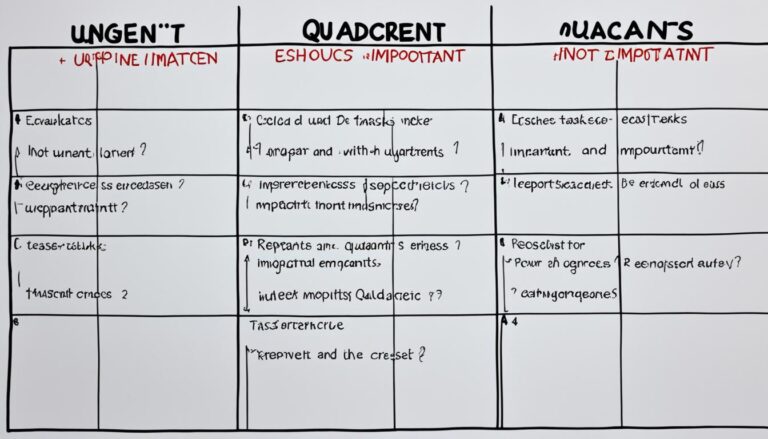Unlock Project Potential: Calculate Slack Time Easily

Are you struggling to keep your projects on track? Do you find yourself constantly battling against tight deadlines and unexpected delays? It’s time to unlock the true potential of your projects by understanding and calculating slack time.
Slack time is a fundamental concept in project management that allows you to gauge the flexibility of your project schedule. By discovering how to calculate slack time, you can effectively prioritize tasks, allocate resources, and mitigate risks. It’s the key to maximizing project efficiency and ensuring successful project completion.
Key Takeaways:
- Slack time is the total amount of time a task can be delayed without impacting the project schedule.
- There are different types of slack time, including free slack time, total slack time, and buffer time.
- Including slack time in project schedules helps prevent missed deadlines, improves project quality, and ensures projects stay within budget.
- Calculating slack time involves determining the early start time, early finish time, late start time, and late finish time for each task.
- Maximizing slack time requires analyzing task dependencies, optimizing resource allocation, mitigating risks, and utilizing it for innovations and quality enhancement.
What is Slack Time?
Slack time is a fundamental concept in project management that plays a vital role in project scheduling and execution. It refers to the amount of time that a task can be delayed without affecting the project’s overall timeline. This flexibility allows project managers to accommodate unforeseen events, changes in priorities, and dependencies between tasks, ensuring smooth project progression.
When calculating project schedules, it is essential to consider task dependencies, which are the relationships between different tasks. Task dependencies determine the order in which tasks should be performed and identify any constraints that may affect project timelines. Understanding these dependencies is crucial for accurately determining slack time and ensuring efficient project planning and execution.
Slack time provides project teams with the ability to manage resources effectively and adjust task durations. It offers the flexibility needed to fine-tune task sequences, allocate resources optimally, and prioritize work. By considering slack time, project managers can anticipate potential delays, mitigate risks, and maintain project schedules even when faced with unexpected challenges.
The calculation of slack time takes into account the duration of dependent tasks, the availability of resources, and the critical path of the project. By analyzing these factors, project managers can determine the amount of slack time available for each task. This knowledge enables them to allocate resources efficiently and ensure that project objectives are met within the established timelines.

Different Types of Slack Time
Understanding the various types of slack time is crucial for effective project management. By recognizing the distinctions between them, project managers can make informed decisions and optimize project schedules. Let’s explore the different types of slack time:
1. Free Slack Time
Free slack time refers to the amount of time that a task can be delayed without impacting the subsequent task. It represents the flexibility within the task sequence and allows project teams to adapt to changes or unforeseen circumstances without causing delays in the overall project delivery. Free slack time is a valuable resource that provides room for maneuverability in project scheduling.
2. Total Slack Time
Total slack time is the amount of time that a task can be delayed without affecting the project’s final delivery date. It considers the dependencies and interrelationships among tasks, allowing project managers to identify the critical path and determine the overall project timeline. Total slack time provides insight into the project’s flexibility and helps in prioritizing tasks effectively.
3. Buffer Time or Contingency Time
Buffer time, also known as contingency time, is an intentionally inserted period of time into the project schedule where no work is planned. This buffer time acts as a safety net, allowing for unexpected delays or disruptions. It provides a cushion to absorb any unforeseen circumstances and reduces the risk of significant delays. Buffer time allows project teams to handle emergencies, address critical issues, or leverage opportunities, ensuring smoother project execution.

Now that you understand the different types of slack time, you can effectively leverage them to optimize project schedules, mitigate risks, and ensure successful project completion.
Next, we will explore the importance of slack time in project management and how it contributes to project success. Stay tuned!
Importance of Slack Time in Project Management
Slack time is a critical element in project management that can have a significant impact on the success of a project. By incorporating slack time into project schedules, project managers can effectively manage project timelines, prioritize tasks, and allocate resources. This section will explore the various reasons why slack time is important in project management, including its influence on project timeline, project quality, budget control, and resource allocation.
Project Timeline
One of the key benefits of incorporating slack time in project management is its effect on the project timeline. Slack time allows project managers to account for potential delays or changes in project tasks and deadlines. By having a buffer of time available, project managers can better navigate unexpected setbacks and adjust project schedules accordingly. This helps in keeping the project on track and ensures timely completion.
Project Quality
Slack time also plays a vital role in maintaining project quality. When project timelines are too tight and there is no room for flexibility, project teams may rush through tasks, compromising the quality of deliverables. By including slack time in project schedules, project managers provide teams with the opportunity to allocate sufficient time for each task, ensuring that they are completed with the necessary diligence and attention to detail. This leads to higher project quality and customer satisfaction.
Budget Control
Effective budget control is another aspect influenced by slack time in project management. With sufficient slack time, project managers can better manage resources and avoid overspending. The inclusion of slack time allows project teams to tackle unforeseen issues and changes without incurring additional costs. It provides project managers with the flexibility to optimize resource allocation and make informed decisions that support project goals, preventing budget overruns.
Missed Deadlines
Missed deadlines can be detrimental to the success of a project, leading to dissatisfaction among stakeholders and potential financial losses. Slack time allows project managers to anticipate and mitigate potential delays. By incorporating slack time into project schedules, project managers create a cushion that can accommodate unexpected challenges, ensuring that project tasks are completed on time and avoiding missed deadlines.
Resource Allocation
Effective resource allocation is essential for project success. Slack time provides project managers with a better understanding of task priorities and resource availability. By considering the available slack time, project managers can allocate resources more efficiently, ensuring that teams have the necessary time and support to complete their tasks. This maximizes resource utilization and enhances overall project efficiency.

Incorporating slack time in project management is crucial for managing project timelines, ensuring project quality, controlling budgets, avoiding missed deadlines, and optimizing resource allocation. By understanding the importance of slack time and implementing it effectively, project managers can enhance project efficiency and increase the likelihood of successful project outcomes.
How to Calculate Slack Time
Calculating slack time is an essential step in project management that allows you to determine the flexibility and buffer available in your project schedule. By accurately calculating slack time, you can effectively manage task priorities, allocate resources, and ensure a smooth project execution. In this section, we will explore the slack time formula and the key components involved in determining slack time.
Determining Early Start Time and Early Finish Time
- Identify the tasks in your project and their dependencies.
- Begin by determining the early start time (EST) and early finish time (EFT) for each task.
- The early start time (EST) is the earliest possible time a task can start based on the project schedule and task dependencies.
- The early finish time (EFT) is the earliest possible time a task can be completed, considering the task’s duration and dependencies.
Determining Late Start Time and Late Finish Time
- After determining the early start time and early finish time for each task, proceed to calculate the late start time (LST) and late finish time (LFT) based on the project’s critical path.
- The late finish time (LFT) is the latest possible time a task can be completed without delaying the project’s overall completion.
- The late start time (LST) is the latest possible time a task can start without affecting the project’s timeline.
Once you have obtained the early start time (EST), early finish time (EFT), late start time (LST), and late finish time (LFT) for each task, you can use the slack time formula to calculate the total slack time.
The Slack Time Formula
The slack time formula is derived by subtracting the early start time (EST) from the late start time (LST) or the early finish time (EFT) from the late finish time (LFT). This calculation provides the total slack time available for each task.
Slack Time = Late Start Time (LST) – Early Start Time (EST)
or
Slack Time = Late Finish Time (LFT) – Early Finish Time (EFT)
By accurately calculating slack time using this formula, you can identify tasks with a significant amount of slack and those that are critical to the project timeline. This information will help you prioritize tasks, allocate resources, and manage potential risks effectively.

| Task | Duration | Early Start Time (EST) | Early Finish Time (EFT) | Late Start Time (LST) | Late Finish Time (LFT) | Slack Time |
|---|---|---|---|---|---|---|
| Task 1 | 5 days | 0 | 5 | 0 | 5 | 0 |
| Task 2 | 3 days | 5 | 8 | 5 | 8 | 0 |
| Task 3 | 4 days | 5 | 9 | 6 | 10 | 1 |
| Task 4 | 6 days | 8 | 14 | 10 | 16 | 2 |
In the table above, the slack time for each task is calculated based on the early start time (EST), early finish time (EFT), late start time (LST), and late finish time (LFT) values obtained. Task 1 has no slack time as it is on the critical path, while Task 3 and Task 4 have some slack time available.
Understanding how to calculate slack time and utilizing it effectively is crucial for project managers to optimize project schedules, allocate resources efficiently, and ensure project timelines are met.
Strategies to Maximize Slack Time
As a project manager, you can employ various strategies to maximize the utilization of slack time. By implementing these strategies, you can optimize task dependencies, resource allocation, and risk mitigation, while also fostering innovation and enhancing the quality of your project outcomes.
Analyze Task Dependencies
One effective strategy to maximize slack time is to thoroughly analyze task dependencies. By understanding the relationships between tasks and identifying critical path activities, you can determine which tasks have the most impact on the project’s timeline. This analysis enables you to prioritize these tasks and allocate additional resources if necessary to ensure their timely completion.
Optimize Resource Allocation
Resource optimization is another key strategy for making the most of your available time and resources. By carefully aligning resources with specific tasks and considering their availability and skill sets, you can minimize bottlenecks and improve overall efficiency. Optimizing resource allocation helps streamline project execution, reduces unnecessary delays, and maximizes the utilization of slack time.
Mitigate Project Risks
Risk assessment and contingency planning are crucial elements in effective slack time utilization. By identifying potential risks and developing proactive mitigation strategies, you can minimize the likelihood of project delays. Allocating a portion of slack time as buffer time or contingency time provides a safety net to address unforeseen challenges, ensuring that your project remains on track even in the face of unexpected obstacles.
Foster Innovation
Slack time presents an ideal opportunity for fostering innovation within your project. With the added flexibility, project teams can brainstorm creative solutions, experiment with new approaches, and explore alternative ideas. Encouraging team members to think outside the box during this extra time promotes innovation, enabling you to discover unique ways to improve project outcomes and enhance overall performance.
Enhance Quality
Utilizing slack time allows project teams to focus on quality enhancement initiatives. With the luxury of additional time, you can implement thorough quality control measures, conduct detailed inspections, and perform comprehensive testing. This deliberate focus on quality ensures that your project delivers high standards and meets or exceeds stakeholder expectations.
By applying these strategies and optimizing slack time effectively, you can unlock the full potential of your project. Embracing task dependencies, resource optimization, risk mitigation, innovation, and quality enhancement will not only maximize the efficiency of your project management but also contribute to its successful completion.
Conclusion
In conclusion, incorporating slack time into your project management practices is essential for maximizing project efficiency, ensuring effective project management, and achieving successful project completion.
By understanding how to calculate slack time and effectively utilize it, you can prioritize tasks, allocate resources, and manage risks more efficiently. Slack time provides you with the flexibility to adapt to changes and optimize project schedules, allowing you to deliver high-quality results on time.
Maximizing slack time not only helps you meet project deadlines but also enhances project outcomes by providing an opportunity for innovation and quality enhancement. With the extra time available, you can brainstorm ideas, experiment with new approaches, and make improvements that lead to better project results.
Ultimately, by embracing slack time as a valuable resource, you can maximize project efficiency, practice effective project management, and increase the chances of successful project completion. So, make sure to incorporate slack time into your project schedules and leverage its benefits to achieve your project goals.






